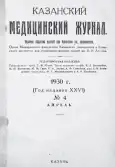К вопросу о зубных дистрофиях у туберкулезных больных
- Авторы: Миртовская Е.В., Гельфенштейн Л.Г.
- Выпуск: Том 26, № 4 (1930)
- Страницы: 363-367
- Тип: Статьи
- URL: https://bakhtiniada.ru/kazanmedj/article/view/54479
- DOI: https://doi.org/10.17816/kazmj54479
- ID: 54479
Цитировать
Полный текст
Аннотация
За последние десятки лет появился в литературе, особенно французской, ряд ценных работ о морфологии и биологии tbc бациллы, внесших новое в понятие механизма передачи tbc от родителей детям. Рядом: патологических вскрытий, экспериментальных и клинических изысканий является уже доказанным возможность врожденного tbc, как одной информ заражения. Но эти наблюдения не окончены, конкретных выводов по этому вопросу еще окончательно не сделано, а потому ценны всякие изменения в организме в период его эмбрионального развития, которые остаются без изменения на всю жизнь. Такого внимания заслуживает зубной аппарат, носящий в себе отпечаток всех дефектов эмбрионального периода. Имея большое движение туббольных в санатории на 250 коек, нам представлялось крайне интересным проследить по материалам зубного кабинета, какие формы зубных дистрофий и частота йх встречается' у туберкулезных больных и при других хронических инфекциях. Мы знаем, как велико диагностическое значение некоторых зубных дистрофий при врожденном сифилисе, и совершенно не знаем таковых при врожденном tbc, несмотря на сходство влияний этих инфекций на жизнь организма. Материал, подлежащий разбору, количественно недостаточен, и зубной кабинет продолжает дальнейшие наблюдения.
Ключевые слова
Полный текст
Открыть статью на сайте журналаОб авторах
Е. В. Миртовская
Автор, ответственный за переписку.
Email: info@eco-vector.com
Россия
Л. Г. Гельфенштейн
Email: info@eco-vector.com
Россия
Список литературы
Дополнительные файлы






